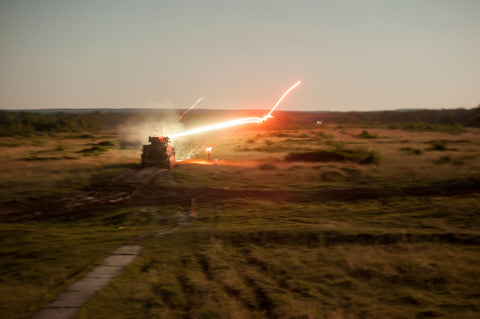
BTR-82A: A Wheeled Armored Troop Carrier — and Frequent Target — in Ukraine
After World War II, the Soviet military began addressing the hazards of riflemen riding to battle atop tank the tanks they accompanied, exposed to enemy gunfire. This would take the form of tracked armored personnel carriers, or APCs, such as the BMP and its airborne contemporary, the BMD, and a series of wheeled BTRs (for "brony transportyor," or "armored transports").
History of the BTR-60 and its successors
The latter first appeared in the form of the BTR-152, a six-wheeled open- topped vehicle that looked like an armored truck — which, for all intents and purposes, it was. During the 1950s, however, the Soviet developed a more specialized eight-wheeled, fully armored vehicle called the BTR-60. Accepted for production by the Gorkovsky Avtomobilny Zavod in 1959, the BTR-60 was unveiled to the public in 1961.
Besides its armor, the BTR-60 was given a conical turret based on that of the BRDM-2 scout car, fitted with a 14.5 mm KPVT and a 7.62 mm PKT coaxial machine gun. Additional armament in theory was to be provided by a series of teardrop- shaped ports in the hull through which the soldiers could engage enemy troops, though in practice that feature often proved more advantageous to the enemy firing on the APC than to the troops within. Besides its roadable capabilities, the BTR was amphibious, with a jet in the rear to propel it over water obstacles and a trim vane up front that when folded up served as supplemental frontal armor.
The BTR-60 appeared in a great many specialized and developmental forms before being phased out from 1972 on by a more powerful successor, the BTR-70, which added roof armor to completely enclose the crew and troops within the vehicle. That in turn led to a further upgrade, the BTR-80, which first appeared in 1984. All three types saw operational use during the ill-fated 1979-1989 Soviet war in Afghanistan, where they proved somewhat more mobile in that country’s rugged environment than their tracked contemporaries. As with Vietnam for the Americans, Afghanistan provided the surviving Russians with combat experience that, among many others, was incorporated into various improvements to the BTR-80.
BTR-80 and BTR-82 Stats
A major change in the BTR-80 was its engine, with a 260 hp KamAZ-7403 diesel replacing the twin 120 hp gas engines that had powered its predecessors. This gives the 15-ton BTR-80 a maximum speed of 55.9 mph on the road, 6.2 mph in the water, a range of 372.8 miles and the ability to negotiate a 60-degree gradient and a 1.64-foot (0.5-meter) step. The vehicle is 25.3 feet long, 9.5 feet wide and 7.9 feet high. As with all the BTRs, it carries a crew of three and seven cramped troops.
Of some psychological benefit to the mobile troops besides the vehicle’s 9 mm frontal and 7 mm side armor and round hull infantrymen’s gun ports in place of the ovoid ones is the installation of a hatch in the rear and two others on either side of the hull, the latter of which opened horizontally to afford the disembarking crewmen some overhead protection and the lower panel providing steps. These gives the soldiers the means to deploy more quickly during an assault or a quicker getaway in the event their vehicle is disabled. The BTR-80 turret also had the elevation of its 14.5 mm machine gun increased to up to 60 degrees, a boon for engaging opposition in mountainous or urban terrain, although the turret is still manually rotated.
In 1985, the BTR-80 was accepted for production by the Arzamas Machine- Building Plant in Nizhny Novgorod, and since then more than 5,000 have been built for the Soviet forces and more than 40 other armies, which have used it in more than a dozen wars throughout the world.
The latest major upgrade, the BTR-82A, went into production in 2009, and by the time it entered service in 2013, Arzamas was also offering an upgrade formula for the original, redesignated the BTR-82AM. Besides the engine being boosted to 300 hp, the chief improvement was in its main armament, a Shipunov 30 mm 2A72 cannon on a modified mantlet with 300 rounds, effective against anything except a main battle tank. The commander’s and gunner’s sights were also improved, and the original searchlights were replaced by PL-1 and later LP-1 infrared spectrum pulse laser searchlights. The extra power also allows for accommodating an eighth soldier in the vehicle.
The BTr-82A in Ukraine
The breakup of the Soviet Union in 1991 left the newly independent Ukraine with some BTRs of various types, including a few of the latest, which saw some use against pro-Russian forces in the Donbas region in 2014. A few were reportedly captured, and since then the Ukrainians seem unwilling to commit them to battle.
Their logic seems borne out since Russian President Vladimir Putin launched his “special military operation” into their country on Feb. 23, 2022. For all the improvements, the BTR-82A remains vulnerable to ambush on the roads and in the towns and cities by a wide variety of infantry weapons, from state-of-the- art Javelins to unguided RPG-7s. Latest reports list 165 BTR-82As and 61 BTR-80s lost, including 62 BTR-82As and 33 BTR-80s captured, and 25 of both models demolished or abandoned. It seems that even with a 30 mm cannon for defense, the BTR-82A is more workhorse than warhorse and more often the target than the hunter.
historynet magazines
Our 9 best-selling history titles feature in-depth storytelling and iconic imagery to engage and inform on the people, the wars, and the events that shaped America and the world.
